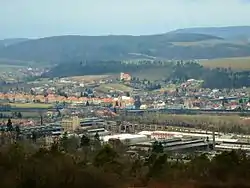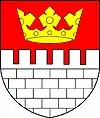Králův Dvůr
Králův Dvůr (pronounced [ˈkraːluːv dvuːr], German: Königshof) is a town in the Central Bohemian Region of the Czech Republic. It has a population of about 9,700. Králův Dvůr creates a conurbation with Beroun.
Králův Dvůr | |
|---|---|
Town | |
 Králův Dvůr | |
 Flag  Coat of arms | |
 Králův Dvůr Location in the Czech Republic | |
| Coordinates: 49°56′48″N 14°2′6″E | |
| Country | |
| Region | Central Bohemian |
| District | Beroun |
| First mentioned | 1253 |
| Government | |
| • Mayor | Petr Vychodil |
| Area | |
| • Total | 15.26 km2 (5.89 sq mi) |
| Elevation | 240 m (790 ft) |
| Population (2020-01-01[1]) | |
| • Total | 9,690 |
| • Density | 630/km2 (1,600/sq mi) |
| Time zone | UTC+1 (CET) |
| • Summer (DST) | UTC+2 (CEST) |
| Postal code | 267 01 |
| Website | www |
History
The history of Králův Dvůr is short because the town was established in 1990 when 7 neighbourhoods left the Beroun municipality. The history of current neighbourhoods, formerly villages or towns, is longer, but slightly different.
Králův Dvůr was in direct royal possession, established in 1236 when Králův Dvůr was a royal hunting residence. A chateau has been preserved, although it was widely damaged by the later D5 highway. Králův Dvůr is known for an incident involving Bohemian king and Holy Roman Emperor Wenceslaus IV of Bohemia. Wenceslaus, escaping from the capital city, was captured by Bohemian nobility on the 8th of May 1394. In 1860, the chateau was sold to Emil Egon Fürstenberg, who had no interest in keeping the property in good shape, and the chateau was used as a warehouse. After WWII, the chateau was nationalized, and state enterprises were maintained by using its buildings as a warehouse. The chateau's garden was used as a path for the D5 highway. The chateau was sold as private property in 2000.
Karlova Hut was an iron smeltery established in the 16th century by the noble family of Karlové ze Svárova. However, the local history of iron smelting is ancient. The settlement was mostly removed in 1960, when the smeltery was expanded to iron works and cement plants were established. The iron works became bankrupt in the 1990s, leaving wide brownfields. The cement plant kept operating.
Křižatky was a small village situated in the hills and was established in 1653.
The first note about Počaply comes from 1253. The Assumption of the Virgin Mary church was built there in 1733. The workers' colony for the nearby iron works was erected in 1905.
Popovice was established in 1296 and was possessed by the Chotěšov monastery. An iron smeltery was situated here, as well as iron mills powered by running water, which were fed by a system of ponds. Two ponds have been preserved – Měřák pond and Popovícký pond.
Levín was established in 1391.
Záhořany was established in 1429, and in 1980 was joined to Beroun. Between 1990 and 2002, Záhořany was an independent municipality, and in 2002, Záhořany joined the municipality Králův Dvůr .
All villages except Záhořany (which shares history with the Králův Dvůr municipality from 2002) were condensed into the single municipality Králův Dvůr in 1850. Králův Dvůr was joined to the Beroun municipality in 1980 as a housing and industrial suburb.
In 1988, the D5 higway was built, splitting Králův Dvůr into two halves. Králův Dvůr left the Beroun municipality in 1990 and was recognized as the new town Králův Dvůr. Iron works were decommissioned in the 1990s, significantly improving air pollution.
In the 21st century, population numbers are growing. Proximity to the capital city of Prague makes Králův Dvůr a favorite place for people to live.
References
- "Population of Municipalities – 1 January 2020". Czech Statistical Office. 2020-04-30.